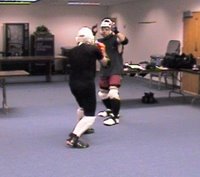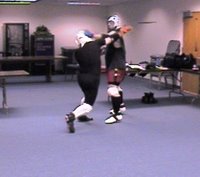[Click photos to enlarge]

1. The fighters square off. How do you close the
gap? Mike is in the black shorts, and I (Nathan) am in the red.

2. The lead-off fighter opens up with a lead-off jab (or palm/finger-jab), which is normally a good lead. This lead draws my rear-hand parry.

3. Mike is finishing his combination, which is a wide ridge-hand or open-hand strike. The counter fighter throws a lead-hand open-hand strike to the ear of the lead-off fighter. This counter is successful because it's thrown inside the lead-off fighter's technique. In other words, my technique is following a more direct route than the lead-off fighter.
What happened? The lead didn't tie up my hands, or create an opening. It was thrown well, but only created a possible opening on the same side, or outside of my right. In photo 2, you may notice that my lead hand is in position to defend or counter.
What could make this combination successful? Three choices:
- Double up the lead. That will draw the parry with the first technique, then perhaps connect with the second. Then I may be off balance or "frozen" for a split-second while the second technique is thrown. Or...
- Feint or fake with the lead, then throw the 1-2 combination. The fake will do the same as a double, but without the commitment, meaning that it's safer. Or...
- If you don't want to double the lead or fake, you and just throw a 1-2 with a straight right or straight palm strike if you're concerned about breaking your hand.
Realize that there are thousands of possible choices for this, but remember that the purpose of a lead is to:
- Close the gap safely (so you don't get hit on the way in)
- Create an opening (by causing a reaction such as a block or retreat)
Hope that helps. Have a blessed Easter weekend!
No comments:
Post a Comment